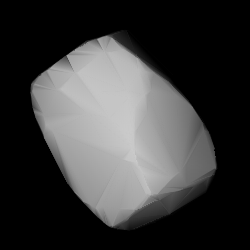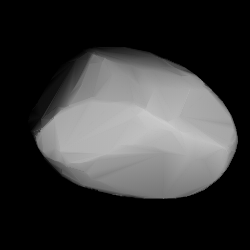
108 Hecuba is a fairly large and bright main-belt asteroid. It was discovered by Karl Theodor Robert Luther on 2 April 1869, and named after Hecuba, wife of King Priam in the legends of the Trojan War in Greek Mythology. This object is orbiting the Sun with a period of 5.83 years and an eccentricity of 0.06. It became the first asteroid discovered to orbit near a 2:1 mean-motion resonance with the planet Jupiter, and is the namesake of the Hecuba group of asteroids.

170 Maria is a Main belt asteroid that was discovered by French astronomer Henri Joseph Perrotin on January 10, 1877. Its orbit was computed by Antonio Abetti, and the asteroid was named after his sister, Maria. This is the namesake of the Maria asteroid family; one of the first asteroid families to be identified by Japanese astronomer Kiyotsugu Hirayama in 1918.

321 Florentina is an S-type (stony) main belt asteroid with a diameter of 28 km. It was discovered by Johann Palisa on 15 October 1891 in Vienna. He named the asteroid for his daughter, Florentine. Between 1874 and 1923, Palisa discovered a total of 122 asteroids.

462 Eriphyla is a Koronian asteroid from the outer regions of the asteroid belt. It was discovered by German astronomer Max Wolf at the Heidelberg-Königstuhl State Observatory on 22 October 1900. The stony S-type asteroid has a rotation period of 8.7 hours and measures approximately 35 kilometers in diameter. It was named after Eriphyle, from Greek mythology.

573 Recha is a minor planet, specifically an asteroid orbiting in the asteroid belt between Mars and Jupiter. The asteroid, discovered by German astronomer Max Wolf on September 19, 1905, was named after a character in Gotthold Ephraim Lessing's play Nathan the Wise and may have been inspired by the asteroid's provisional designation 1905 RC.
575 Renate is a minor planet, specifically an asteroid orbiting in the asteroid belt which was discovered by German astronomer Max Wolf on September 19, 1905. The name may have been inspired by the asteroid's provisional designation 1905 RE.
639 Latona is a minor planet, specifically an asteroid orbiting in the asteroid belt. It was discovered by German astronomer Karl Lohnert on July 19, 1907, at Heidelberg.
660 Crescentia is a minor planet orbiting the Sun that was discovered by American astronomer Joel Hastings Metcalf on January 8, 1908. The name may have been inspired by the asteroid's provisional designation 1908 CC. Peter Ting points out that the Rev. Joel Metcalf of Taunton (Massachusetts) discovered six asteroids with unexplained names, though listed in Lutz Schmadel's book. Ting used an on-line planetarium website to help with the location of some of the planets, playing back to the night of discovery. He noticed that there was a crescent moon (33%) low in the western sky and wonders if the Rev. Metcalf could have named the asteroid for the Moon. Crescentia would be a very unusual name for a person but not for a phase of the Moon.
677 Aaltje is a main-belt minor planet orbiting the Sun, discovered by August Kopff at Heidelberg on January 18, 1909. It was named after the Dutch singer Aaltje Noordewier-Reddingius.
742 Edisona is a minor planet, specifically an asteroid orbiting in the asteroid belt that was discovered by German astronomer Franz Kaiser on February 23, 1913. It was named for inventor Thomas Edison. This asteroid is orbiting 3.01 AU with a period of 5.22 years and an eccentricity of 0.119. The orbital plane is inclined at an angle of 11.2° to the plane of the ecliptic. This is a member of the dynamic Eos family of asteroids that most likely formed as the result of a collisional breakup of a parent body.
962 Aslög is a minor planet orbiting the Sun that was discovered by German astronomer Karl Wilhelm Reinmuth on 25 October 1921. Measurements of the lightcurve made in 2010 and 2011 give a rotation period of 5.465 ± 0.01 hours. It has a diameter of 39.5 km (24.5 mi).
1955 McMath, provisional designation 1963 SR, is a stony Koronis asteroid from the outer region of the asteroid belt, approximately 10 kilometers in diameter.
1079 Mimosa, provisional designation 1927 AD, is a stony Karin or Koronian asteroid from the outer regions of the asteroid belt, approximately 20 kilometers in diameter. It was discovered on 14 January 1927, by Belgian–American astronomer George Van Biesbroeck at the Yerkes Observatory in Williams Bay, Wisconsin. The asteroid was named after the flowering plant Mimosa.
6980 Kyusakamoto, provisional designation 1993 SV1, is a stony Koronis asteroid from the outer region of the asteroid belt, approximately 9 kilometers in diameter. It was discovered by Japanese astronomers Kin Endate and Kazuro Watanabe at Kitami Observatory on 16 September 1993. The asteroid was named after Japanese singer Kyu Sakamoto.

1223 Neckar, provisional designation 1931 TG, is a stony Koronian asteroid from the outer region of the asteroid belt, approximately 25 kilometers in diameter. Discovered by Karl Reinmuth at Heidelberg Observatory in 1931, the asteroid was named for the German river Neckar. The S-type asteroid has a rotation period of 7.8 hours.
133528 Ceragioli, provisional designation 2003 TC2, is an asteroid of the Koronis family from the outer regions of the asteroid belt, approximately 1.75 kilometers (1.1 miles) in diameter. It was discovered on 4 October 2003 by American astronomer David Healy at the Junk Bond Observatory in Arizona, United States. The likely stony and possibly elongated asteroid has a rotation period of 3.1 hours. It was named for American optician Roger Ceragioli.

1848 Delvaux is a stony Koronis asteroid from the outer region of the asteroid belt, approximately 17 kilometers in diameter. It was discovered on 18 August 1933, by Belgian astronomer Eugène Delporte at the Royal Observatory of Belgium in Uccle, Belgium. It was later named after astronomer Georges Roland's sister-in-law.
2123 Vltava, provisional designation 1973 SL2, is a stony Koronian asteroid from the outer region of the asteroid belt, approximately 15 kilometers in diameter. It was discovered on 22 September 1973, by Soviet–Russian astronomer Nikolai Chernykh at the Crimean Astrophysical Observatory on the Crimean peninsula in Nauchnyj. It is named for the river Vltava (Moldau).
12838 Adamsmith, provisional designation 1997 EL55, is a stony Koronis asteroid from the outer region of the asteroid belt, approximately 6 kilometers in diameter. The asteroid was discovered on 9 March 1997, by Belgian astronomer Eric Walter Elst at ESO's La Silla Observatory in northern Chile. It was named after Scottish philosopher and economist Adam Smith.
12564 Ikeller, provisional designation 1998 SO49, is a stony Koronian asteroid from the outer region of the asteroid belt, approximately 5 kilometers in diameter.







